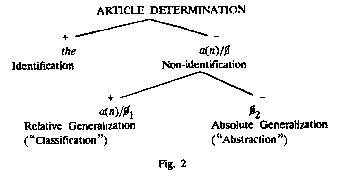
39
The day (subject) was drawing to a close, the busy noises of the city (subject) were dying down. How to
handle the situation was a big question (predicative). The sky was pure gold (predicative) above the setting sun.
It should be noted that in many other cases of syntactic use, i.e. non-subjective or non-predicative, the
articles reflect the same situational functions. This can be probed by reducing the constructions in question on
re-arrangement lines to the logically "canonized" link-type constructions. Cf:.
If you would care to verfy the incident (object), pray do so. > If you would care the incident (subject) to be
verified, pray have it verified. I am going to make a rather strange request (object) to you. > What I am going
to make is a rather strange request (predicative) to you. You are talking nonsense (object), lad. > What you
are talking, lad, is nonsense (predicative).
Another essential contextual-situational characteristic of the articles is their immediate connection with the
two types of attributes to the noun. The first type is a "limiting" attribute, which requires the definite article
before the noun; the second type. is a "descriptive" attribute, which requires the indefinite article or the
meaningful absence of the article before the noun. Cf:.
The events chronicled in this narrative took place some four years ago. (A limiting attribute) She was a
person of strong will and iron self-control. (A descriptive attribute) He listened to her story with grave and
kindly attention. (A descriptive attribute)
The role of descriptive attributes in the situational aspect of articles is particularly worthy of note in the
constructions of syntactic "convergencies", i.e. chained attributive-repetitional phrases modifying the same
referent from different angles. Cf:.
My longing for a house, a fine and beautiful house, such a house I could never hope to have, flowered into
life again.
§ 4. We have now come to the third stage of the undertaken analysis of the English articles, namely to their
consideration in the light of the oppositional theory. The oppositional examination of any grammatically
relevant set of lingual objects is of especial importance from the point of view of the systemic conception of
language, since oppositions constitute the basis of the structure of grammatical paradigms.
Bearing in mind the facts established at the two previous stages of observation, it is easy to see that
oppositionally, the article determination of the noun should be divided into two binary correlations connected
with each other hierarchically.
The opposition of the higher level operates in the whole system of articles. It contrasts the definite article
with the noun against the two other forms of article determination of the noun, i.e. the indefinite article and the
meaningful absence of the article. In this opposition the definite article should be interpreted as the strong
member by virtue of its identifying and individualizing function, while the other forms of article determination
should be interpreted as the weak member, i.e. the member that leaves the feature in question ("identification")
unmarked.
The opposition of the lower level operates within the article subsystem that forms the weak member of the
upper opposition. This opposition contrasts the two types of generalization, i.e. the relative generalization
distinguishing its strong member (the indefinite article plus the meaningful absence of the article as its analogue
with uncountable nouns and nouns in the plural) and the absolute, or "abstract" generalization distinguishing the
weak member of the opposition (the meaningful absence of the article).
The described oppositional system can be shown on the following diagram (see Fig. 2).
It is the oppositional description of the English articles that involves the inteipretation of the article non-use
as the zero form of the article, since the opposition of the positive exponent of the feature to the negative

